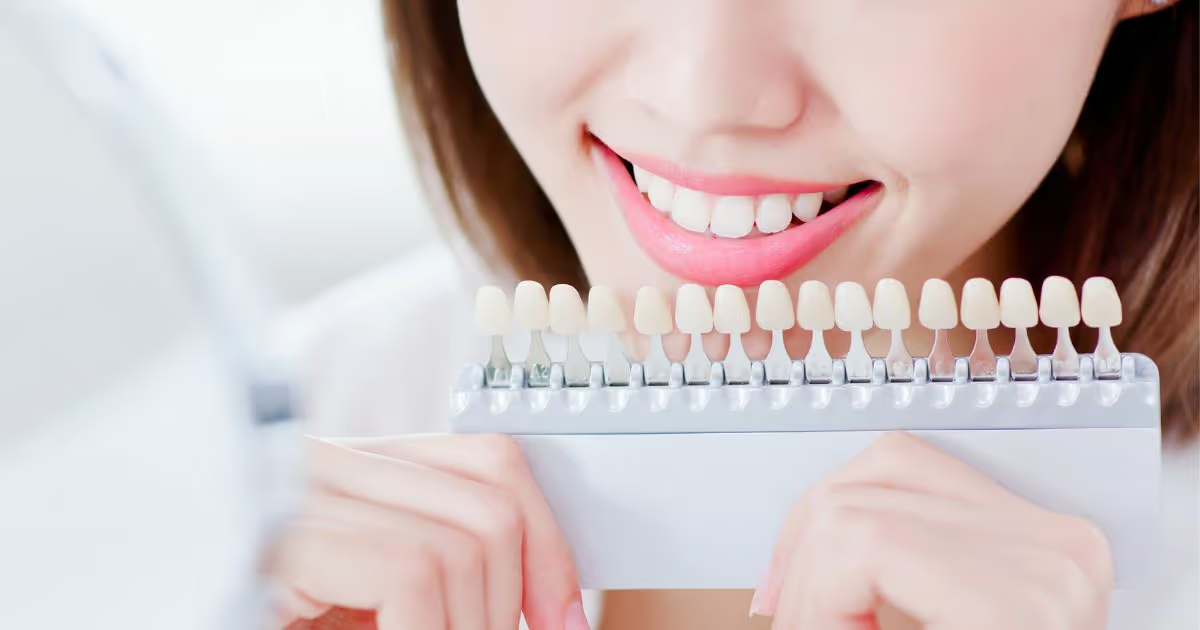Teeth Whitening Treatment
Teeth whitening treatment is a dental procedure that helps transform discolored or stained teeth into stunning white, bright teeth by utilizing teeth whitening technology, the LED Light System, and high-quality bleaching products to stimulate the disintegration of the whitening gel, which help turn discolored teeth into white, bright, and natural-looking teeth. The treatment restores the teeth to a pearly white, shining condition and helps a treated person regain confidence with a sunny smile.
What causes teeth to turn yellow, black, or discolored?
Yellow, black, dark, or brown teeth stains are due to two main factors:
- Extrinsic staining
- Foods and beverages contain chemicals, such as pre-chromogens, chromogens, or tannin, such as tea, coffee, red wine, soft drinks, and specific dark-colored fruit and vegetable juices. These will attack the teeth and bind to the white tooth enamel, causing yellow, black, or brown staining and making teeth appear darker.
- Tar or nicotine in cigarettes: Smoking is a primary cause of yellow teeth, black teeth, or dark teeth. The toxins in cigarettes will bind to the outer layer of teeth and become ingrained, causing the teeth to darken quickly. Smoking also causes a buildup of plaque, which is the principal contributor to gum disease, tooth decay, periodontal gum disease, and many other dental ailments.
- Intrinsic discoloration
- Aging: Our tooth enamel naturally thins with aging, allowing pigment from food and beverages to become more easily embedded in the enamel. As a result, the teeth turn yellow, brown, or darker.
- Gum and tooth injuries that darken the color of the teeth: When the gums and teeth are injured, the body reacts by producing a thicker layer of dentin to protect the original dentin from destruction. However, it can also darken the color of the teeth. Additionally, injuries to the gums and teeth can also cause blood to seep into the teeth, changing the color of the teeth.
- Certain medications, such as asthma or blood pressure medications, as well as some antibiotics used by mothers while pregnant, such as tetracycline or doxycycline, as well as when infants or young children are given antibiotics during the teething period or excessive fluoride exposure, can cause teeth to darken when they grow up. In addition, those undergoing treatment for certain diseases, such as cancer, may experience tooth darkening as a side effect of cancer treatment.
How many types of teeth whitening treatment?
There are two types of teeth whitening that are widely accepted and popular:
- Philips Zoom teeth whitening products (hospital- or clinic-based) are a tooth whitening procedure that uses a high-performance tooth whitening gel containing hydrogen peroxide in combination with energy wave stimulation. Shining an adjustable blue LED light spanning three intensity levels on the teeth helps to break up the dull stains and reveal noticeably whiter teeth right after the procedure without harming the tooth enamel. The outcome is dependent on the state of each individual's teeth.
- Home bleaching (Philips Zoom products), or at-home teeth whitening, is the procedure of bleaching your teeth at home using a tooth whitening kit that includes trays and teeth whitening gel. The dentist will make a mouth impression at the hospital to make teeth whitening trays and give the initial teeth whitening, then dispense an at-home teeth-whitening kit for continuing teeth whitening at home. At-home teeth whitening is a convenient way to whiten teeth, suitable for those who do not have time or those who want to increase the level of whiteness to a satisfactory level.
What is the procedure for Zoom Teeth Whitening treatment?
- The dentist will diagnose the oral cavity and the condition of the teeth to compare the shade of the teeth before starting the teeth-whitening process. If limestone is present, the dentist will remove the tartar, polish the teeth, or fill any cavity before bleaching for the teeth-whitening gel to work at peak efficiency.
- The dentist applies the cheek, tongue, lips, and gum barrier, as well as a protective gel on the gums and surrounding tissues to prevent the whitening gel from contacting the buccal and gum tissues inside the mouth and wears special blue light-blocking glasses to protect eyesight while performing the teeth whitening procedure.
- The dentist will use a blow-dry tool to dry the teeth, then apply the teeth whitening gel to bleach the teeth.
- The dentist uses the Zoom device's WhiteSpeed blue LED light to stimulate the gel polish to dissolve and penetrate through the enamel layer to remove stains and turn the yellow, brown, or dull black dentin into a whiter shade of teeth.
- The dentist will coat the teeth-whitening gel and repeat the light for 3–4 rounds, each session spaced approximately 15 minutes apart. The teeth-whitening process takes about 45 minutes to an hour, depending on the condition of each individual's teeth. After the last session, the dentist will apply a special fluoride coating to the teeth to help reduce tooth sensitivity.
- When the teeth-whitening process is complete, the dentist will suck out the whitening gel and wipe to clean the teeth, gums, tongue, and mouth area. Then, assess the outcome by comparing the teeth colors before and after teeth whitening to discern the improvement in whiter, brighter teeth.
What is the Home Bleaching and Teeth Whitening procedure?
- The dentist performs a thorough oral examination, including the oral cavity and teeth. An oral clearance may be required if limestone is detected. The dentist will remove the tartar, polish the teeth, or perform dental fillings to prepare the teeth surface for bleaching.
- The dentist will take an impression of the mouth for making trays for home teeth whitening.
- After receiving the teeth whitening tray, the dentist will fit it to the teeth and gums to check if they all fit snugly.
- The dentist will demonstrate how to use the teeth whitening kit, clean and store the equipment.
- Teeth whitening or self-whitening at home involves squeezing the right number of teeth whitening gel as specified by the dentist onto the teeth whitening tray. Then, apply the whitening tray over the teeth and leave for 30 minutes (depending on the whitening gel concentration).
- If sensitive teeth are detected, temporarily avoid using toothpaste with a high fluoride concentration for a short while.
What is the aftercare for Zoom Whitening Treatment?
- The dentist will advise refraining from smoking for at least a week after treatment and avoiding foods and beverages that can cause tooth discoloration, such as tea, coffee, red wine, soft drinks, deep-colored fruit juices, and sour foods high in acid.
- The dentist may prescribe painkillers such as Ponstan, Nurofen, or Arcoxia to relieve the pain of toothache or sensitive teeth.
- Avoid drinking hot and cold drinks for a while to prevent tooth sensitivity.
- Those with teeth sensitivity as a treatment side effect are advised to use hyposensitivity or fluoride-containing toothpaste to relieve the symptoms.
- The dentist recommends regular oral care, including gum and tooth cleaning, with twice-a-day brushing and flossing to reduce plaque buildup and maintain a pearly white smile for a long time.
- Schedule an oral health check-up with a professional dentist at least every six months.
What is the benefit of Zoom Teeth Whitening treatment?
- Zoom Teeth Whitening treatment is accepted for being convenient and fast, not to mention offering an immediate result of visibly shining bright whitening right after the treatment. Ultimately, the treatment takes approximately 45 minutes, which is very efficient and time-saving.
- No damage to teeth enamel, dentin, or any natural structure of the teeth
- Safe, free of significant side effects, and worry-free of any pain during the treatment.
- Able to repeat teeth whitening without limit, whether at the hospital or home, whenever or wherever, as long as needed.
What is the disadvantage of teeth whitening?
- Teeth whitening can cause tooth sensitivity or irritation of the gum tissue, but the symptoms will only last for approximately a few days and then resolve.
- Teeth-whitening treatments may not be effective for those with purplish-red, gray, or freckled teeth from antibiotic treatment.
- Teeth whitening treatment does not change the color of other dental materials, including fillings, dentures, crowns, and veneers, to be as white as other natural teeth surface after the treatment or bleaching.
Do teeth whitening treatments really whiten teeth?
Quality teeth-whitening systems can help whiten teeth. There are various types of teeth whitening available, depending on the condition of each individual's tooth, and depending on teeth whitening kits. The teeth whitening effect will last for approximately six months to one year, after which the color of the teeth will start to darken from daily eating and drinking. However, one can repeat the teeth-whitening treatment as often as desired without affecting the dentin.
Who can benefit from teeth whitening treatments?
Teeth whitening is accepted as a gold standard dental procedure that whitens the teeth of those with yellow, black, brown, or other discolored teeth to brighten and lift the confidence of the owner's smile. Those who benefit from tooth whitening treatments include:
- Anyone wishing for a pearly white smile, a sparkling smile full of confidence.
- Those who require a good-looking appearance, a flawless look, and pleasant smiles to impress people they meet.
- Those who enjoy drinking tea, coffee, wine, soft drinks, and deeply colored juices.
- Those who enjoy eating spicy, sour, and hot food.
- Smokers
- Those who have yellow teeth from antibiotics.
- Those who have yellow or dark teeth as a side effect of receiving medical treatment.
Who is not suitable for teeth whitening?
- For those with ongoing dental issues, e.g., gum disease, tooth decay, root canal inflammation, or periodontitis, the whitening gel can penetrate the decayed area and roots of the teeth, which may cause sensitive teeth. If the disease is present, the dentist will first provide treatment to reduce discomfort and affect a cure, followed by a teeth-whitening procedure.
- Those under 16 years of age, due to the developing nerve to the tooth, can have tooth sensitivity.
- Pregnant or breastfeeding mothers.
Where can I get the best teeth whitening treatment?
Effective teeth whitening result hinges on the type and quality of the whitening product to ensure the safety and best possible outcome of white sparkling teeth that help accentuate a dazzling smile.
Additionally, teeth-whitening treatment in a digital dental center is indispensable for the accurate, rapid production of mold of the teeth. Ideally, a tooth whitening at a reputable hospital with cutting-edge dental technology and an international standard teeth-whitening kit helps create trust and confidence for the best service before and after the treatment.
Do teeth whitening treatments hurt?
Teeth whitening treatment is a painless procedure. In some cases, the teeth may become sensitive. However, the symptoms will disappear within 48 hours.
How long do the whitened teeth last?
After completing teeth whitening treatment, the whiteness of the teeth will last from six months to one year, depending on daily oral hygiene practices. Neglecting a daily care routine can hasten teeth darkening. Therefore, scheduling an appointment with a dental professional every six months to check the oral and tooth conditions is recommended to help maintain the whiteness of the teeth over longer term.
Zoom Teeth Whitening prices at MedPark Hospital






